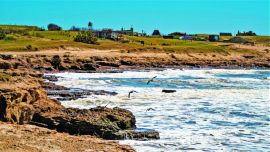For humans, truffles – distant cousins of mushrooms in the fungi kingdom – are revered as culinary gold, giving pasta or risotto dishes an elegant, savoury twist when shaved or grated on top.
A new study published Thursday in Current Biology shows that ground-dwelling birds of Patagonia also seek out and disperse the ecologically important tubers, passing viable spores through their faeces.
Matthew Smith, senior author of the study and a plant pathology professor at the University of Florida, told AFP he and collaborators from Chile and Argentina stumbled on the finding as they were documenting the fungi of the region.
Truffles are normally found under the leaf litter, just above the soil.
"We would find evidence of those being uncovered, and then sometimes evidence that they had scratch marks, like what you see when chickens are scratching for things," he said.
What's more, ground foraging birds of remote, undisturbed regions started following the researchers around as they sought truffles.
"When you're looking for truffles, that disturbs the leaf litter, and they'll follow behind you and look through the parts you disturbed."
The team also found that the truffles of the region were similar in size and shape as fruit – one of the most common food sources for birds, in addition to seeds and invertebrates – which suggested the fungi might have evolved to look attractive to birds.
At one point, first author Marcos Caiafa even saw a bird eat a chunk of truffle in front of him.
To confirm their hypothesis, the team began collecting the droppings of chucao tapaculos and black-throated huet-huets and tested them for DNA.
Truffle DNA was found in 42 percent of chucao tapaculo and 38 percent of huet-huet feces.
They also examined the bird poop using fluorescent microscopy, to confirm that the spores were viable, suggesting that the birds were responsible for spreading them.
Truffles are known to depend on mammals, such as pigs, to spread their spores, as opposed to mushrooms, which can shoot off their spores.
Smith explained that, apart from adding to the body of scientific knowledge, the new finding has important implications.
Truffles are mostly mycorrhizal fungi, which means they have a relationship with trees, helping them take up nutrients in exchange for sugars.
"These trees are the foundation of that ecosystem, and these fungi are symbiotic with the trees. So it's now a three-way connection between birds, fungi and the trees," he said.
From a conservation perspective, the ecosystems of Patagonia are under increasing pressure.
Birds' movements become more restricted when disturbed by people, and that could in turn impact the fungi, the trees, and the wider ecosystem.
Smith said that while the discovery was made in South America, it's likely that ground-dwelling birds are involved in spreading truffles in other regions, such as North America – but the technologies to confirm this weren't readily available until recently.
– AFP
























Comments